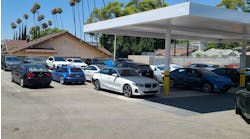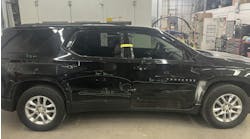This article was originally published Sept. 1, 2007. Some of the information may no longer be relevant, so please use it at your discretion.
When a vehicle is involved in a collision, there is a high probability that the front or rear suspension components of the vehicle may also have sustained damage. Typically, damaged suspension components may not show outward signs of that damage. Therefore, in most cases, suspension components are only included in an estimate when they are literally hanging from the vehicle and the need to replace them is obvious.
In many shops, mechanical diagnosis and subsequent repairs often are addressed last, after collision damage has been repaired. This usually occurs the day before or day of delivery. Invariably, while attempting an alignment, your mechanical shop discovers damage that was not seen during the body repairs, making on-time delivery impossible.
The vehicle owner already has been told that his vehicle is going to be ready "today," so now you have a major customer satisfaction index (CSI) situation. Does this sound familiar?
All of us have been through it. The really sad thing is that even though this scenario has played out many times, there often isn't enough effort made in body shops to avoid it in the future. That's a bigger problem, but one that is easily solved by thoroughly and completely diagnosing the suspension damage up front.
It is possible to accurately, easily, and quickly diagnose damage to a suspension component using a few simple methods. Let's first look at (in very simple terms) the most often used and basic suspension construction components.
The basics
Understanding how typical suspension components function, and how they are constructed will provide the basis for better damage estimates. The suspension system, although not absolutely essential to the operation of a motor vehicle, makes a huge difference in the vehicle's drivability. Basically, it acts like a "bridge" between the occupants of the vehicle and the surface of the road.
The term suspension refers to the ability of this bridge to "suspend" a vehicle's frame, body, and power train above the wheels. Remember when you were younger and you went riding your skateboard, roller skates, or roller blades? All three have direct contact with the road. You feel every crack, pebble and bump. This is what your car would feel like without a suspension system softening the ride.
Think about several different ride styles you experience while driving in different vehicles. In a sporty car, the ride is usually stiffer and tighter. This type of "sport" suspension allows for better cornering ability. When riding in a luxury car, you kind of "float" down the road, feeling very little of the unevenness of the driving surface.
Both suspensions look similar but provide a very different function. They both "suspend" the vehicle. The term suspension in general refers to mainly the components that we described earlier. In collision repair, however, suspension damage can include driveline damage, such as to axles and CV joints.
For the purposes of this article, a suspension component on any vehicle can involve several basic aspects of the vehicle's control functions. They either help steer the vehicle, help stabilize or smooth the ride of the vehicle, or help drive/propel the vehicle. Most motorized vehicles have a front suspension and a rear suspension, both involving different variants of the basic three suspension functions.
Front suspension
The front suspension of many vehicles can involve all three aspects of the basic suspension functions. They are used to steer, propel (as in a front- or four-wheel drive vehicle), and soften and stabilize the ride of the vehicle. Front-wheel drive vehicles have been in production for years, with one of the first being the Cord built in the 1930s. For most of automotive history, however, the rear-wheel drive vehicle was the most popular style.
In recent years the reverse has been true, with rear-drive vehicles being mostly luxury vehicles and trucks. There are many variations of the front suspension component involved in a rear-wheel drive system, but for the purposes of this discussion, I want to stick to more conventional units that are encountered most often.
In the typical rear-wheel drive front suspension, there are several main components that make up the suspension assembly:
- Upper and lower control arms
- Hub, bearing and knuckle
- Strut or shock absorber
- Drive axles
This assembled unit is sometimes called a knee assembly and can be purchased as an LKQ (used) assembly. Obviously, the major difference between a standard front suspension and a front-wheel drive suspension is the fact that the drive axles of the vehicle are located in the front of the vehicle instead of the rear.
Rear suspension
The rear suspension of a modern vehicle can range from basic, like a beam axle used on many front-wheel drive vehicles, to as complex as a Corvette independent rear suspension. Rear suspensions also can serve the three basic suspension functions, just as a front suspension. Basic components of a rear suspension are:
- Axle housing
- Axle
- Hub and bearings
- Shocks/struts
- Upper and lower control arms
The photo below shows a typical rear suspension on a normal front-wheel drive vehicle. As diverse as all these suspension/ drive options are, diagnosing the damage to all of these components is basically straightforward. To stay on track when examinging these parts, there are three basics to remember:
- Inspect
- Measure
- Document
Most suspension components consist of forged steel, cast steel or aluminum, and they are not repairable when bent in a collision. In general, for safety concerns, never attempt to straighten a damaged suspension component. Always replace the damaged part with a new one.
Note: Always examine the front suspension for damage while writing an estimate if the wheel was impacted directly. If the vehicle went off-road during the collision; or if the vehicle has sustained cowl, unibody or front rail damage.
In these cases, during the estimate process, it is imperative the vehicle be lifted up so that access can be gained to the suspension for clear viewing. The wheels and tires should be removed as well. When estimating suspension damage, it is important to perform a thorough inspection that provides proof of the damage you are listing on the estimate, backed by factual information.
Never list a part on an estimate if you are just "guessing" it is damaged and needs replacement. In reality, the term "estimate" indicates guesswork by its definition and is open-ended. What you should be providing for your customers and insurance partners is not an estimate, but rather a comprehensive listing of the damage to their vehicle, or what I call a "blueprint for repair," much like the blueprint used in building your home. It should be concise, and detailed, addressing all the damage and how it is to be repaired.
You should always be able to justify what you are writing with photos, measurements, and manufacturer's information as documentation. Because of the extra time involved for this type of inspection, it may be difficult to do during a drive-in estimate when your potential customer is in a hurry. However, it is an important step that will prevent many repair delays later and provide your customer with a more accurate assessment of the vehicle's damage.
A quick and easy indicator of potential suspension damage is to measure the wheel base on each side of the vehicle. A tram gauge or even a tape measure will work for this. If there is a difference in this measurement from side to side, it's likely there is some type of suspension damage to the vehicle.
You will find that if you explain the appraisal process to your customer up front, they will be understanding and allow you the time needed to accurately assess the damage.
Optimally, you would write an appraisal without the customer even leaving the car. If you can capture the repair before writing any type of appraisal, you would be able to do a thorough inspection and teardown and accurately assess the repair cost. I try to do this in every case possible.
Remember that you are not in the business of writing estimates; you are in the business of repairing cars. Get the keys up front. Your customers come to you because they need their vehicle repaired, not estimated.
Once clear access has been gained to the area, inspect the knuckle for signs of potential damage. In a cast steel component, stress cracks or flaking are indicative of potential damage. Since stamped steel components (control arms in some cases) are sometimes painted or coated, flaking of this coating might indicate damage to the component.
Look at the suspension mounting points, including the engine cradle, in the case of a front-wheel drive vehicle, for movement around the bolt holes. Inspect the shocks or struts for leaks, bends or punctures. Shocks can bend fairly easily under the force of a collision impact. Bent or damaged struts or shocks are not repairable and require replacement.
Note: Measure the suspension and cross reference.
Generally, most professional and modern collision shops have access to underbody and suspension reference measurements through their frame spec books, a mechanical estimating system or the vehicle manufacturer's published guides. Utilizing simple measuring tools like a tram gauge or a tape measure, you can reference the correct dimensions in your spec books, and then against the vehicle, using established reference points to determine damage.
Document your measurements on paper and take photographs of measurements that are not within specifications (Usually tolerances in this area are available from the manufacturer). The mounting of suspension components is fairly precise, so slight variations from standard can cause major problems with safety and drivability. This is a powerful diagnostic method. Necessary repairs cannot be argued by anyone if you have the backup.
Drive axles should be inspected for tears in the boots or dust covers over the constant velocity (CV) joints. Drive axles have two CV joints, as they are commonly called, on each axle shaft. These should be thoroughly inspected in any frontal impact on a front-wheel drive vehicle.
If dirt or road grime get into a CV joint, it is very damaging to the joint, which is basically a U-joint similar to a drive shaft on a rear-wheel drive vehicle. The grit eventually will erode the joint enough to necessitate replacement. If during a visual inspection you have any doubts about the integrity of an axle shaft, write time to remove it and have it inspected and tested at a professional axle repair/fabrication company.
They may even be willing to come to you to diagnose and document damage if you are unsure. If you don't feel comfortable diagnosing suspension damage, ask your mechanic to look at the vehicle for you when writing your estimate. If you use a sublet mechanical shop, they can write you an estimate for the repairs, and you will have a good base figure to include on your appraisal.
As I mentioned earlier, guessing at damage is not acceptable to any reputable collision shop or insurance company. Documenting the damage to the suspension component by close visual inspection, measurements, and photos will solidify your overall estimate. It also will speed up cycle time substantially by finding normally undiagnosed damage at the onset of the repair process rather than near the end. I also recommend doing the mechanical repairs to your collision- damaged vehicles first. Using this production methodology will keep cycle time low and customer satisfaction high.
Accurately diagnosing damage under a vehicle is really not a mystery, it involves all the same principles you use every day in writing estimates on exterior sheet metal. Take some time to learn as much as you can about suspensions and how they function, and you will be able to diagnose damage much more accurately. I recommend I-CAR, ATEG, and training through vehicle manufacturers to gain the knowledge needed to become a suspension damage expert.
Knowledge is power, better CSI, and improved profitability.



